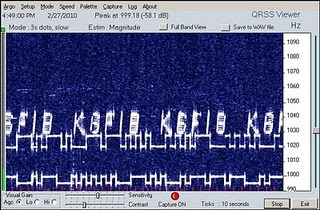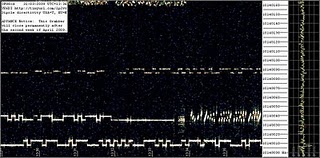In the previous posts we were described issues related to slow Morse code transmission, bandwidth (BW), signal to noise ratio (SNR) and operating modes such us QRSS and its variants. Today we will make one small step forward and we will see how these modes are used inside amateur radio for experimentation and propagation research. In future postings and within 3rd party references for experimentation with slow code transmission, you must keep in mind that the term "QRSS" is used in general.
MEPTs
For ionospheric propagation experiments the most common practice is the usage of radio beacons. Radio beacons are unattended transmitters that repeat a callsign in Morse code (most of the times) and the listeners by identifying each beacon can know if the specific moment of reception there is a propagation opening between their location and the location-country of the beacon. In many countries the amateur radio license forbids the licensee to operate a beacon without first obtaining special permission and/or an extension to the license. In some countries the licensing conditions relating to beacon operation are confusing. With QRSS operating it is quite common for low power transmitters to work for extended periods of time therefore it was felt among QRSS experimenters that is important to clarify their position with respect to beacons.

Since the QRSS experiments are directed at achieving the detection of very weak radio signals at great distances and examining how the prevailing propagation conditions affect those signals it was decided that a new term should be found to describe any QRPp slow code transmitting equipment which best suited these activities. After several threads on mailing lists related to QRSS experimentation over many months, the term "MEPT" was arrived that stands for Manned Experimental Propagation Transmitter. The "Manned" part of the term MEPT is simply to make clear that these transmitters are supervised at all times. The "Experimental" means just that, an experimental transmitter while the "Propagation" part of the term attempts to make it clear that QRSS transmitters are a method of observing propagation effects on radio signals. Above all QRSS experimenters try to avoid the term "beacon" because this can be a "sensitive" issue.
QRSS Knights
QRSS Knights is a worldwide known group of QRSS enthusiasts, that are doing experiments mostly on 30m (10140.0 - 10140.1 KHz) & 40m (7000.8 - 7000.9 KHz) and sometimes on 80m (3500.8 - 3500.9 KHz). I am not sure when they started to exist as group but I learned about them back in 2002. All of the experiments are done on QRSS, FSKCW, DFCW and some other slow code transmission modes like HELL. The maximum working power is below 500mW. Most of the times the power is 100 to 200 mW and there are cases were the experimentation goes down to the microwatts region. The QRSS Knights group consists from radio amateurs that work MEPTs or QRSS Grabbers and they exchange information and reception reports through the knightsqrss mailing list or the knightsqrss clipboard. As you may already understood… I am one of the QRSS Knights.

References:
[1] M0AYF, The term "M.E.P.T." explained, http://www.qrss.thersgb.net/MEPT.html
[2] QRSS Knights, Mailing List, http://cnts.be/mailman/listinfo/knightsqrss_cnts.be
[3] QRSS Knights, Clipboard, http://www.on5ex.be


